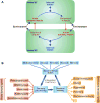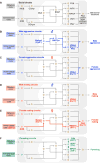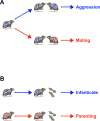Neural Circuit Mechanisms of Social Behavior
- PMID: 29621486
- PMCID: PMC6028944
- DOI: 10.1016/j.neuron.2018.02.026
Neural Circuit Mechanisms of Social Behavior
Abstract
We live in a world that is largely socially constructed, and we are constantly involved in and fundamentally influenced by a broad array of complex social interactions. Social behaviors among conspecifics, either conflictive or cooperative, are exhibited by all sexually reproducing animal species and are essential for the health, survival, and reproduction of animals. Conversely, impairment in social function is a prominent feature of several neuropsychiatric disorders, such as autism spectrum disorders and schizophrenia. Despite the importance of social behaviors, many fundamental questions remain unanswered. How is social sensory information processed and integrated in the nervous system? How are different social behavioral decisions selected and modulated in brain circuits? Here we discuss conceptual issues and recent advances in our understanding of brain regions and neural circuit mechanisms underlying the regulation of social behaviors.
Copyright © 2018 Elsevier Inc. All rights reserved.
Figures




References
Publication types
MeSH terms
Grants and funding
LinkOut - more resources
Full Text Sources
Other Literature Sources

